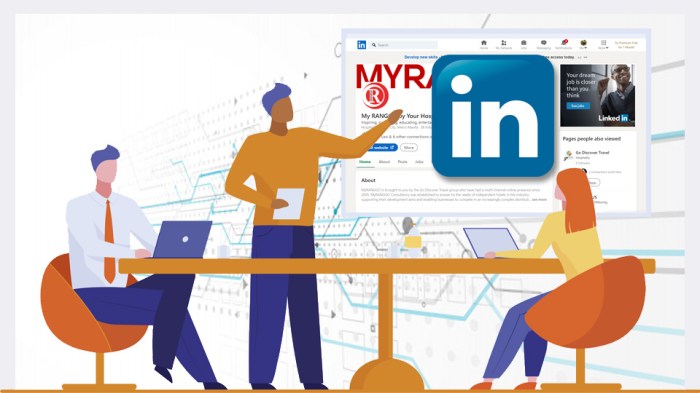Kicking off with Using LinkedIn for Employee Advocacy, this guide dives into the power of leveraging social media to amplify your brand’s influence and reach. From strategies to success stories, get ready to unlock the potential of employee advocacy on LinkedIn.
Importance of Employee Advocacy on LinkedIn
Employee advocacy on LinkedIn refers to the practice of employees sharing and promoting their company’s content, products, and services on their personal LinkedIn profiles. This form of advocacy can greatly benefit both the employees and the company itself.
Benefits of Utilizing LinkedIn for Employee Advocacy
- Increased Reach: Employees sharing company content can help reach a wider audience on LinkedIn, expanding the company’s online presence.
- Enhanced Credibility: When employees share content related to their expertise, it adds credibility to the company and its offerings.
- Boosted Engagement: Employee advocacy can lead to higher engagement rates, as personal connections are more likely to interact with content shared by someone they know.
Examples of Successful Employee Advocacy Campaigns on LinkedIn
- Microsoft’s “Microsoft Life” campaign encouraged employees to share their experiences working at the company, showcasing the positive culture and opportunities available.
- IBM’s #NewWayToWork campaign involved employees sharing insights on the future of work, positioning IBM as a thought leader in the industry.
- Dell’s “Social Media and Community University” program trained employees on social media best practices and encouraged them to share company updates and initiatives on LinkedIn.
Strategies for Leveraging LinkedIn for Employee Advocacy: Using LinkedIn For Employee Advocacy
In order to effectively leverage LinkedIn for employee advocacy, it is important to implement best practices that encourage participation, create engaging content, and measure the impact of these efforts.
Encouraging Employees to Advocate on LinkedIn
- Provide training sessions or workshops to educate employees on the benefits of employee advocacy and how to effectively use LinkedIn for this purpose.
- Recognize and reward employees who actively engage in advocacy efforts on LinkedIn, whether through incentives, shoutouts, or other forms of appreciation.
- Encourage employees to personalize their content and share their own perspectives and experiences to make their posts more authentic and relatable.
Creating Engaging Content for Employees to Share on LinkedIn, Using LinkedIn for Employee Advocacy
- Develop a content calendar that includes a mix of company updates, industry news, thought leadership pieces, and employee spotlights to keep the content varied and interesting.
- Utilize multimedia elements such as images, videos, and infographics to make posts more visually appealing and engaging for employees and their networks.
- Encourage employees to share company culture-related content, including behind-the-scenes looks, team accomplishments, and employee testimonials, to showcase the human side of the organization.
Measuring the Effectiveness of Employee Advocacy Efforts on LinkedIn
- Track key metrics such as engagement rates, click-through rates, follower growth, and lead generation to assess the impact of employee advocacy on LinkedIn.
- Utilize LinkedIn analytics tools to monitor the performance of individual employees’ posts and identify top performers who can serve as ambassadors for the program.
- Solicit feedback from employees on their experiences with advocacy efforts and use this input to refine strategies and improve outcomes over time.
Building a Strong Employee Advocacy Program on LinkedIn

Building a successful employee advocacy program on LinkedIn requires establishing clear guidelines, providing effective training, and engaging leadership support.
Establishing Guidelines and Policies
- Create a detailed document outlining the dos and don’ts of employee advocacy on LinkedIn.
- Clarify the type of content that is appropriate for sharing and the company’s messaging guidelines.
- Ensure employees understand the importance of transparency and authenticity in their posts.
Tips for Training Employees
- Offer workshops or webinars to educate employees on the best practices for engaging on LinkedIn.
- Provide examples of successful posts and campaigns to inspire and guide employees.
- Encourage employees to personalize their content and share their unique perspectives.
Role of Leadership
- Leaders should lead by example by actively participating in employee advocacy efforts on LinkedIn.
- Provide recognition and rewards for employees who excel in their advocacy efforts.
- Empower managers to support and encourage their teams to engage on LinkedIn.
Tools and Technologies for Managing Employee Advocacy on LinkedIn

Employee advocacy programs on LinkedIn can be effectively managed with the help of various software platforms designed to streamline the process, enhance engagement, and track the impact of employee advocacy efforts. These tools play a crucial role in ensuring the success of the program and maximizing its benefits.
Software Platforms for Managing Employee Advocacy Programs
There are several software platforms available that can assist in managing employee advocacy programs on LinkedIn. These platforms offer features such as content scheduling, employee engagement tracking, and analytics to measure the effectiveness of the program. Some popular tools include:
- Hootsuite: A social media management platform that allows users to schedule posts, monitor engagement, and track performance metrics for employee advocacy campaigns.
- LinkedIn Elevate: LinkedIn’s own platform for employee advocacy, providing content suggestions, scheduling capabilities, and insights into employee engagement and reach.
- EveryoneSocial: A platform focused on employee advocacy, providing tools for content sharing, tracking employee engagement, and measuring the impact on LinkedIn.
Importance of Analytics and Reporting Tools
Analytics and reporting tools are essential for tracking the impact of employee advocacy on LinkedIn. These tools help in measuring key metrics such as reach, engagement, and conversions, allowing organizations to assess the effectiveness of their advocacy efforts and make data-driven decisions. Some key features of analytics and reporting tools include:
- Performance metrics: Tracking the performance of employee advocacy campaigns in terms of reach, clicks, likes, shares, and comments.
- Conversion tracking: Monitoring the impact of employee advocacy on lead generation, website traffic, and other conversion metrics.
- Employee engagement insights: Providing data on employee participation, content sharing behavior, and overall engagement levels on LinkedIn.